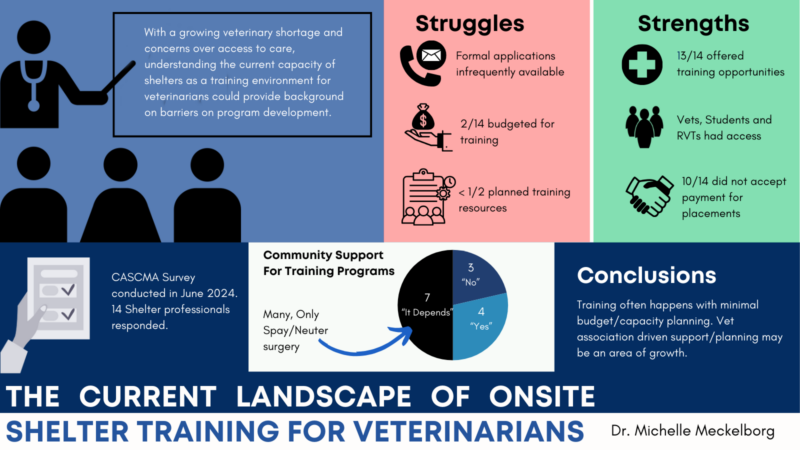By Dr. Michelle Meckelborg, Shelter Veterinarian, Director of Animal Health, Maddie’s UW/UCD Shelter Medicine Fellow 2022

A survey was released in June 2024 to the CASCMA membership to better understand the roadblocks shelter’s experience with respect to veterinary training capacity. Shelters are balancing requests from students and veterinary colleagues both domestic and internationally trained to use the shelter as a learning ground whilst maintaining heavy workloads and high standards of care.
Fourteen shelter professionals took part in the survey. The overwhelming majority of shelters did provide teaching opportunities to veterinary professionals (13/14). Of the 13 respondents who offered placements – the most common offering was for school-age students interested in veterinary medicine (7/13), private practitioners (7/13), university students (9/13), technical placements (9/13). Fewer shelters offered higher level training to internationally trained students (2/13). One respondent reported only providing ‘pre-vet’ training because veterinary time was limited or there was no veterinarian on staff. The single shelter that did not provide training opportunities indicated that cost and time/space constrictions were the driving factors.
The most common method for the interested parties to inquire about training opportunities was by phone or email query (6/9) with only 3/9 respondents indicating an alternative method (1/9 walk-in/word of mouth, 2/9 formal referral process). This suggests that in most shelters, there is not a clearly delineated process for participation in training programs and by extension, it is less likely for there to be defined selection criteria for entry into said programs. Only 1 respondent indicated that their veterinary body oversees a formalized training program. In the face of a veterinary professional shortage, the lack of association-driven support for training is a potential area for further growth.
A potentially contentious question garnered interesting answers: Do you believe your community would support the use of shelter animals for teaching?
4/14 respondents indicated ‘Yes’, firmly. These organizations explain that the link to an existing educational institution (veterinary school) increases the communities’ willingness to accept veterinary training or that the shelter has normalized training, so limited opposition exists.
3/14 respondents answered ‘No’. One respondent indicated the community was likely to support but the organization was not. One respondent answered no, citing laws that indicate animals cannot be used for experimentation being translated to teaching and training and one respondent suggested it was highly unlikely to be accepted by their community.
“Animal advocates believe that training is causing the animals harm”. -Anonymous Respondent
7/14 were in the ‘It Depends’ category. In the situation where the benefit-risk ratio favored the animal over the student or if the level of supervision/standard of care for animals being used for teaching animals was the same as for other shelter animals and, the animal was not subject to unnecessary procedures, then the answer was yes. Multiple respondents indicated that the only type of training accepted would be surgical training in spay/neuter.
Funding
Only 2 of 14 shelters currently budget for training, with a wide range from $500 – $10,000+. The allocated funding was directed towards extra DVM staffing, with medical supplies and extra support staffing as close second.
Training Capacity
5/14 of shelters actively plan for the training opportunities by defining a ‘training capacity’. In descending order, the factors used to determine capacity are: seasonality (4/5), staffing levels (4/5), expected case load (3/5) and potential revenue (1/5).
“Capacity for care is often already reached and having inexperienced personnel could increase mistakes/lead to problems (ie more surgical complications)”. -Anonymous Respondent
one fifth (4/14) of shelters accepted payment for training placements. Of the rest (10/14) that did not accept payment, the most common reasons were: never been offered (7/10), did not believe it was the norm (6/10), did not believe shelters should accept payment for teaching placements (1/10).
And the million-dollar question to wrap it up – What do you see as the biggest challenge to offering training opportunities in a shelter setting?
By far, the rate limiting step was reported to be staffing limitations, high workload and time constraints. Seasonality played a factor for one respondent, indicating case load was too high during summer and too low to be meaningful in the winter. Cost also played a role for one organization, suggesting that compensation for the loss of revenue incurred when providing training would increase the number of placements offered. Lack of access to a veterinarian or low buy-in from on-staff veterinarian was reported to be the primary reason for not offering training for several organizations.
Takeaways!
Training veterinary professionals in a shelter setting is often ‘off the side of the desk’ with minimal budgetary or capacity planning. Offerings to school-aged/university students or technical programs are generally more accessible when DVM limitations of time/workload are present. The perception that veterinary professional training in animal shelters intersects with animal harm exists. Efforts to educate the public on this topic may be required. Veterinary association-driven support for training may be a potential area of growth.
